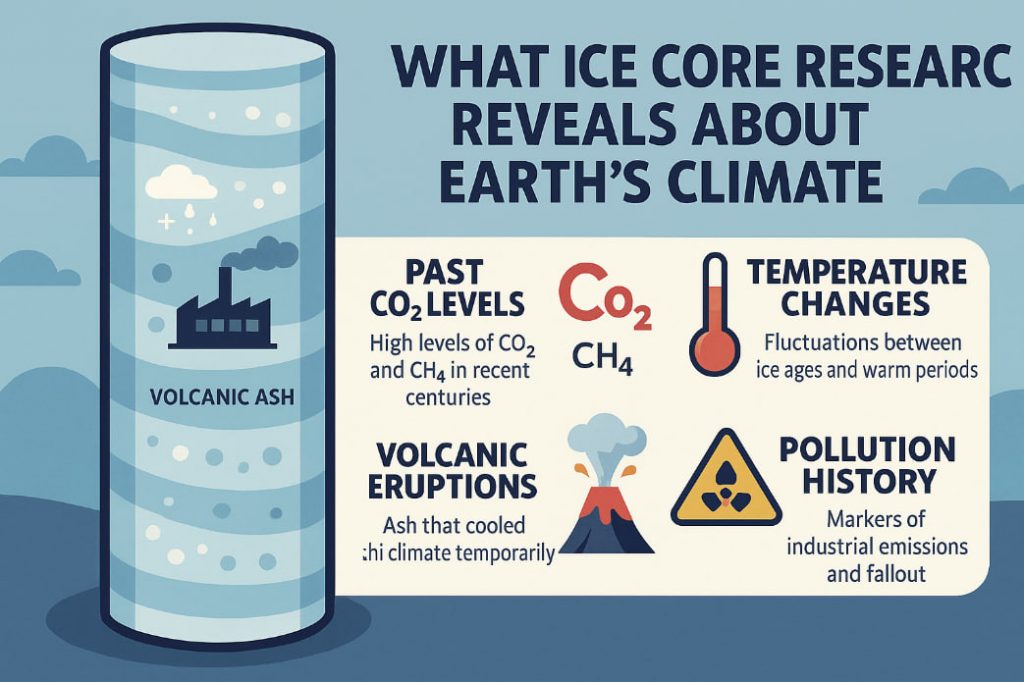Ice cores are frozen time capsules that preserve the story of Earth’s climate across hundreds of thousands of years. Drilled from glaciers and ice sheets in Antarctica, Greenland, and alpine regions, these long cylinders of compacted snow allow scientists to examine the past in incredible detail. Recent research using ice cores has deepened our understanding of climate change, carbon cycles, and the influence of human activity on the planet’s atmosphere.
What Are Ice Cores and How Are They Collected?
Ice cores are extracted using specialized drills that bore deep into glaciers. Each layer in an ice core represents a year or season, similar to tree rings, with trapped air bubbles, dust, volcanic ash, and chemical traces frozen in place.
Key collection sites include:
- East Antarctica (e.g., Dome C) – yielding cores over 800,000 years old;
- Greenland’s ice sheet – offering high-resolution records of the last glacial period;
- Tibetan Plateau and Andes – providing regional climate signals.
Researchers store and analyze these cores in ultra-cold labs to avoid contamination or melting.
What Do Ice Cores Tell Us?
- Past CO₂ Levels: Bubbles in ice preserve ancient air samples. Ice cores reveal carbon dioxide (CO₂) and methane (CH₄) levels.
- Temperature Fluctuations: Ratios of stable oxygen and hydrogen isotopes show past temperature cycles, including ice ages and warm periods.
- Volcanic Activity: Layers of ash and sulfur reveal past eruptions and their cooling effects on global climate.
- Solar and Oceanic Cycles: Ice cores help reconstruct long-term climate drivers like Milankovitch cycles and El Niño–Southern Oscillation (ENSO) patterns.
- Pollution History: Recent layers show spikes in lead, sulfates, and radioactive isotopes from industrial emissions, nuclear tests, and fossil fuel combustion.
What Recent Ice Core Studies Show
- Accelerated Warming: Ice cores confirm that the current warming trend is unprecedented in both speed and magnitude over hundreds of thousands of years.
- Tipping Points: Analyses suggest that rapid melting events and sudden climate shifts in the past could recur if warming continues unchecked.
- Polar Amplification: Antarctica and Greenland are warming faster than mid-latitude regions, which may destabilize ice sheets and raise sea levels.
- Interglacial Comparisons: Earth’s current interglacial period (Holocene) has experienced unusually stable temperatures — until recent decades.
These findings are central to climate models and global policy-making.
Why Ice Core Research Matters
- Informs Climate Policy: Ice core data supports international climate reports and treaties (e.g., IPCC, Paris Agreement).
- Predicts Future Trends: Understanding how Earth responded to past CO₂ levels helps model future changes.
- Highlights Human Impact: Clear chemical markers show when human activities began significantly altering the atmosphere.
As the climate crisis deepens, ice cores provide objective, long-term evidence that guides both science and society.
Glossary
- Ice core: A cylindrical sample of ice drilled from glaciers to analyze past climates.
- Isotopes: Variants of elements used to infer temperature and atmospheric composition.
- Milankovitch cycles: Long-term changes in Earth’s orbit that affect climate.
- Interglacial period: A warm phase between ice ages.
- Carbon dioxide (CO₂): A greenhouse gas emitted by burning fossil fuels and a key driver of climate change.


